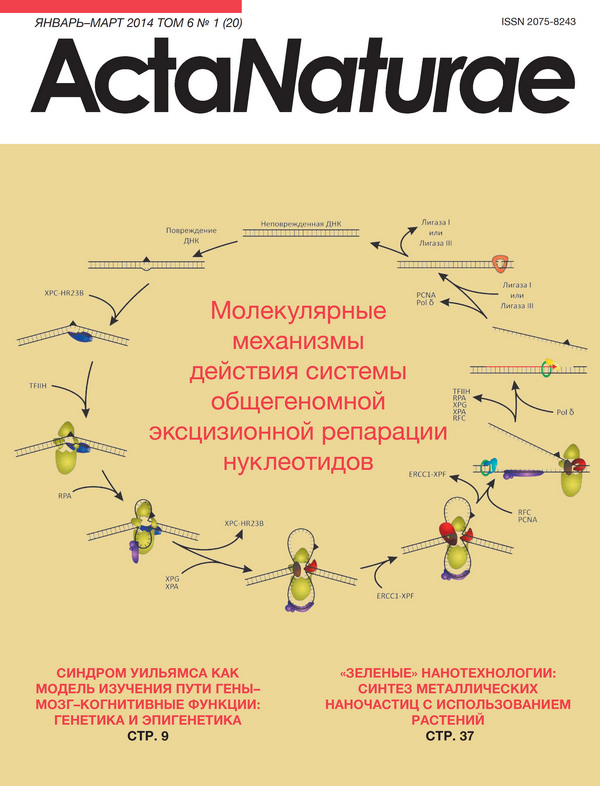Generation of iPS Cells from Human Hair Follice Dermal Papilla Cells
- Authors: Muchkaeva I.A.1,2, Dashinimaev E.B.1,2, Artyuhov A.S.2, Myagkova E.P.1,2, Vorotelyak E.A.1,2, Yegorov Y.Y.3, Vishnyakova K.S.3, Kravchenko J.E.3,4, Chumakov S.P.3,4, Terskikh V.V.1, Vasiliev A.V.1
-
Affiliations:
- Koltsov Institute of Developmental Biology, Russian Academy of Sciences
- Pirogov Russian National Research Medical University
- Engelhardt Institute of Molecular Biology, Russian Academy of Sciences
- Shemyakin and Ovchinnikov Instituse of Bioorganic Chemistry, Russian Academy of Sciences
- Issue: Vol 6, No 1 (2014)
- Pages: 45-53
- Section: Research Articles
- URL: https://actanaturae.ru/2075-8251/article/view/10556
- DOI: https://doi.org/10.32607/20758251-2014-6-1-45-53
- ID: 10556
Cite item
Abstract
Dermal papilla (DP) cells are unique regional stem cells of the skin that induce formation of a hair follicle and its regeneration cycle. DP are multipotent stem cells; therefore we supposed that the efficiency of DPC reprogramming could exceed that of dermal fibroblasts reprogramming. We generated induced pluripotent stem cells from human DP cells using lentiviral transfection with Oct4, Sox2, Klf4, and c-Myc, and cultivation of cells both in a medium supplemented with valproic acid and at a physiological level of oxygen (5%). The efficiency of DP cells reprogramming was ~0.03%, while the efficiency of dermal fibroblast reprogramming under the same conditions was ~0.01%. Therefore, we demonstrated the suitability of DP cells as an alternative source of iPS cells.
About the authors
I. A. Muchkaeva
Koltsov Institute of Developmental Biology, Russian Academy of Sciences; Pirogov Russian National Research Medical University
Author for correspondence.
Email: izomerizaciya@list.ru
Russian Federation
E. B. Dashinimaev
Koltsov Institute of Developmental Biology, Russian Academy of Sciences; Pirogov Russian National Research Medical University
Email: izomerizaciya@list.ru
Russian Federation
A. S. Artyuhov
Pirogov Russian National Research Medical University
Email: izomerizaciya@list.ru
Russian Federation
E. P. Myagkova
Koltsov Institute of Developmental Biology, Russian Academy of Sciences; Pirogov Russian National Research Medical University
Email: izomerizaciya@list.ru
Russian Federation
E. A. Vorotelyak
Koltsov Institute of Developmental Biology, Russian Academy of Sciences; Pirogov Russian National Research Medical University
Email: izomerizaciya@list.ru
Russian Federation
Y. Y. Yegorov
Engelhardt Institute of Molecular Biology, Russian Academy of Sciences
Email: izomerizaciya@list.ru
Russian Federation
K. S. Vishnyakova
Engelhardt Institute of Molecular Biology, Russian Academy of Sciences
Email: izomerizaciya@list.ru
Russian Federation
J. E. Kravchenko
Engelhardt Institute of Molecular Biology, Russian Academy of Sciences; Shemyakin and Ovchinnikov Instituse of Bioorganic Chemistry, Russian Academy of Sciences
Email: izomerizaciya@list.ru
Russian Federation
S. P. Chumakov
Engelhardt Institute of Molecular Biology, Russian Academy of Sciences; Shemyakin and Ovchinnikov Instituse of Bioorganic Chemistry, Russian Academy of Sciences
Email: izomerizaciya@list.ru
Russian Federation
V. V. Terskikh
Koltsov Institute of Developmental Biology, Russian Academy of Sciences
Email: izomerizaciya@list.ru
Russian Federation
A. V. Vasiliev
Koltsov Institute of Developmental Biology, Russian Academy of Sciences
Email: izomerizaciya@list.ru
Russian Federation
References
- Oliver R.F. // J. Embryol. Exp. Morphol. 1967. V. 18. № 1. P. 43-51.
- Ohuama M., Kobayashi T., Sasaki T., Shimizu A., Amagai M. // J. Cell Sci. 2012. V. 125. № Pt17. P. 4114-4125.
- Shutova M.V., A.N. Bogomazova, M.A. Lagarkova, S.L. Kiselev // ActaNaturae. 2009. V. 1. № 2. P. 104-106.
- Takahashi K., Yamanaka S. // Cell. 2006. V. 126. № 4. P. 663-676.
- Liskovykh M. A., Chuykin I. A., Ranjan A., Safina D. A., Tolkunova E. N., Minina Yu. M., Zhdanova N. S., Dyban P. A., Mullins J., Kostyleva E. I. et al. // Tsitologiya. 2011. V. 53. № 12. P. 927-934.
- Higgins C., Ito M., Inoue K., Richardson G., Jahoda K., Cristiano A. // Exp. Dermatol. 2010. V. 19. № 6. P. 568.
- Higgins C., Ito M., Inoue K., Richardson G., Jahoda K., Cristiano A. // J. Invest. Dermatol. 2012. V. 136. № 6. P. 1725-1727.
- Medvedev S.P., Grigor’eva E.V., Shevchenko A.I., Malakhova A.A., Dementyeva E.V., Shilov A.A., Pokushalov E.A., Zaidman A.M., Aleksandrova M.A., Plotnikov E.Y. et. al. // Stem Cells Dev. 2011. V. 20. № 6. P. 1099-1112.
- Warren L., Manos P.D., Ahfeldt T., Loh Y.H., Li H., Lau F., Ebina W., Mandal P.K., Smith Z.D., Meissner A. et al. // Cell Stem Cell. 2010. V. 7. № 5. P. 618-630.
- Chermnykh E. S., Radyukhina N. V., Rutkevich P. N., Shevelyov A. Y., Vlasik T. N., Vorotelyak E. A., Vasiliev A. V., Terskikh V. V. // Tsitologiya. V. 52. № 3. P. 219-224.
- Ohnuki M., Takahashi K., Yamanaka S. Generation and Characterization of Human Indused Pluripotent Stem Cells. Curr. Protoc. Stem Cell Biol. 2009. Chapter 4:Unit 4A.2. doi: 10.1002/9780470151808.sc04a02s9.
- Li R., Liang J., Ni S., Zhou T., Qing X., Li H., He W., Chen J., Li F., Zhuang Q., et. al. // Cell Stem Cell. 2010. 7 № 1. P. 51-63.
- Kim D., Kim C.H., Moon J.I., Chung Y.G., Chang M.Y., Han B.S., Ko S., Yang E., Cha K.Y., Lanza R. et. al. // Cell Stem Cell. 2009. V. 4. № 6. P. 472-476.
- Marchetto M.C., Yeo G.W., Kainohana O., Marsala M., Gage F.H., Muotri A.R. // PLoS One. 2009. V. 4. № 9. e7076.
- Gnedeva K.Y. // Candidate Thesis, M., 2012.
- Yehezkel S., Rebibo-Sabbah A., Segev Y., Tzukerman M., Shaked R., Huber I., Gepstein L., Skorecki K., Selig S. // Epigenetics. 2011. V. 6. № 1. P. 63-75.
- Rendl M., Polak L., Fuchs E. // Genes Develop.2008. V. 22. № 4. P. 543-557.
- Prokhorova, T.A., L.M. Harkness, U. Frandsen, N. Ditzel, H. D. Schroder, J.S. Burns, M. Kassem. // Stem Cells Dev. 2009. V. 18. № 1. P. 47-54.
- Zhang W.Y., de Almeida P.E., Wu J.C. // 2012. Teratoma formation: A tool for monitoring pluripotency in stem cell research. StemBook [Internet], doi/10.3824/stembook.1.53.1. http://www.stembook.org.
Supplementary files







